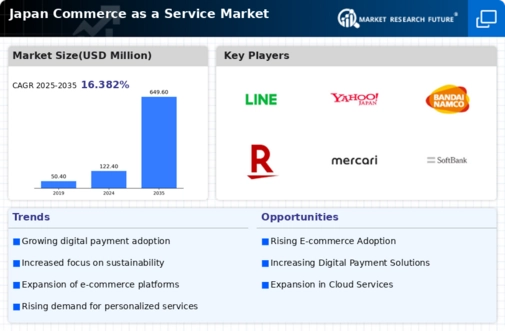Rise of E-commerce Adoption
The rapid increase in e-commerce adoption in Japan is a primary driver for the commerce as-a-service market. As of 2025, e-commerce sales in Japan are projected to reach approximately $200 billion, reflecting a growth rate of around 15% annually. This surge is largely attributed to changing consumer behaviors, with more individuals preferring online shopping due to its convenience and accessibility. The commerce as-a-service market is benefiting from this trend, as businesses seek to enhance their online presence and streamline operations. Companies are increasingly turning to as-a-service solutions to manage their e-commerce platforms efficiently, allowing them to focus on core business activities while leveraging advanced technologies to improve customer engagement and satisfaction.
Expansion of Mobile Commerce
Mobile commerce expansion is significantly influencing the commerce as-a-service market in Japan. With over 80% of the population owning smartphones, mobile shopping has become a dominant channel for consumers. In 2025, mobile commerce is expected to account for nearly 50% of total e-commerce sales in Japan. This shift necessitates that businesses adopt commerce as-a-service solutions that are optimized for mobile platforms. Companies are increasingly focusing on mobile-friendly interfaces and payment solutions to enhance user experience. As a result, the commerce as-a-service market is witnessing a surge in demand for services that facilitate seamless mobile transactions, thereby enabling businesses to capture a larger share of the growing mobile consumer base.
Increased Focus on Operational Efficiency
Operational efficiency is a critical driver for the commerce as-a-service market in Japan. Businesses are under constant pressure to reduce costs and improve productivity. As of 2025, it is estimated that companies utilizing commerce as-a-service solutions can achieve operational cost reductions of up to 30%. This efficiency is primarily due to the automation of various processes, such as inventory management and order fulfillment. By leveraging as-a-service models, businesses can streamline their operations, reduce overhead costs, and allocate resources more effectively. This trend is particularly relevant in the highly competitive Japanese market, where operational excellence is essential for sustaining profitability and growth in the commerce as-a-service market.
Regulatory Compliance and Security Concerns
Regulatory compliance and security concerns are increasingly shaping the commerce as-a-service market in Japan. As businesses expand their online operations, they face stringent regulations regarding data protection and consumer privacy. In 2025, it is projected that compliance-related costs will account for approximately 15% of operational expenses for e-commerce businesses. Consequently, companies are turning to commerce as-a-service solutions that offer built-in compliance features and robust security measures. This trend not only helps businesses mitigate risks associated with data breaches but also enhances consumer trust. As the regulatory landscape continues to evolve, the ability to ensure compliance will be a key differentiator for companies operating in the commerce as-a-service market.
Demand for Customization and Personalization
In the commerce as-a-service market, the demand for customization and personalization is becoming increasingly pronounced. Japanese consumers are seeking tailored shopping experiences that cater to their individual preferences. This trend is evident in the growing use of data analytics and artificial intelligence to create personalized marketing strategies. As of 2025, it is estimated that 70% of consumers in Japan prefer brands that offer personalized experiences. Consequently, businesses are investing in commerce as-a-service solutions that enable them to deliver customized offerings, thereby enhancing customer loyalty and driving sales. Adapting to consumer preferences is crucial for companies aiming to thrive in the competitive landscape of the commerce as-a-service market.

















Leave a Comment